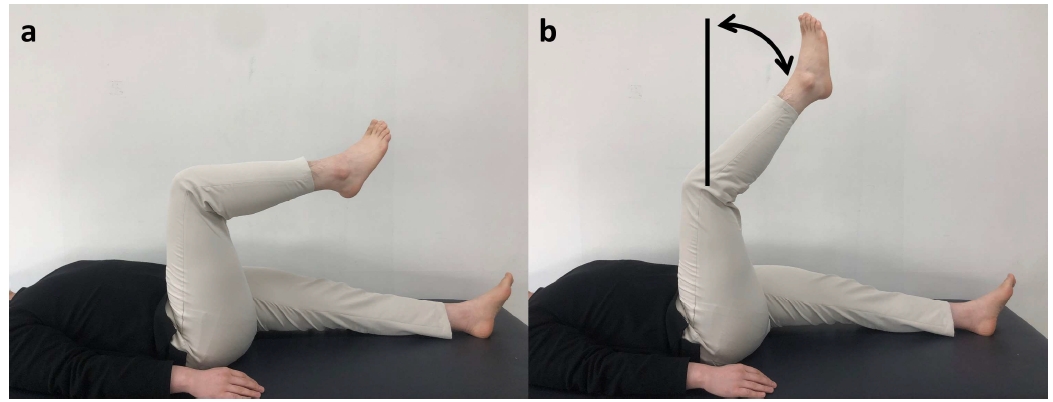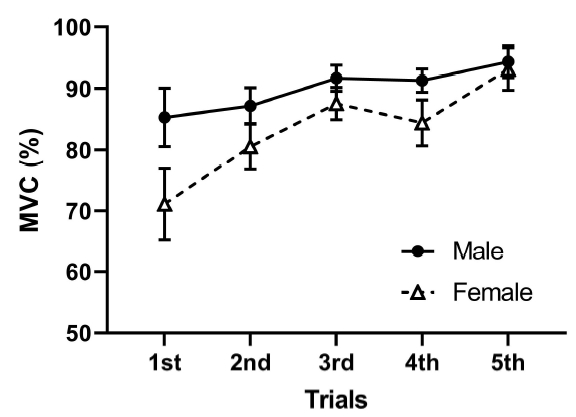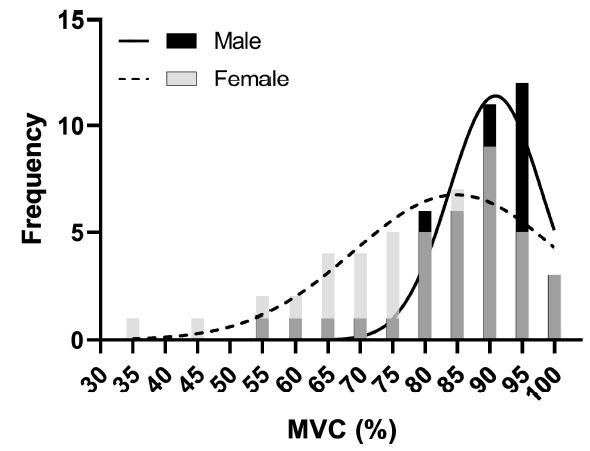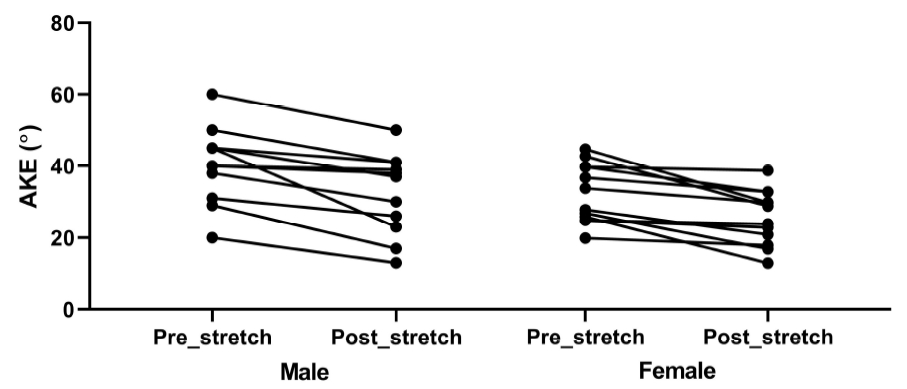
최대 수의적 수축 동안 뒤넙다리근 근력 반복성의 남녀 차이
© 2020 by the Korean Physical Therapy Science
Abstract
This study aimed to examine the repeatability of hamstring strength during maximal voluntary contractions (MVCs) and to examine the sex difference.
Quasi-experiment design.
The study recruited 23 healthy young individuals as participants. Hamstring flexibility was measured before and after MVCs by active knee extension test. Five trials of MVCs were performed, and hip extension forces were measured using a strain gauge during MVCs. Repeatability was confirmed by intraclass correlation coefficient (ICC) and coefficient of variation, and the difference between male and female participants was confirmed by independent samples t-test.
The forces measured during MVCs were significantly different between men and women over five trials. We observed the minimum and maximum force production at the first and fifth trial of MVCs in both men and women. Excellent to moderate reliability of the hamstring strength during MVCs was found in men (ICC range, 0.70–0.98) and women (ICC range, 0.66–0.90). There was no significant difference in hamstring flexibility between men and women.
In clinical settings, we recommend excluding the first trial of MVCs in both men and women. Additionally, performing at least three trials of MVCs would be useful to improve the reliability of the baseline measures in women.
Keywords:
Flexibility, Hamstring muscles, Maximum voluntary contraction, RepeatabilityⅠ. 서 론
임상에서 최대 수의적 수축(maximum voluntary contraction) 동안 근력 측정은 여러 측면에서 중요한 의미를 갖는다. 먼저, 이를 통해 재활치료 프로그램 수립을 위한 기준선 설정이 가능하고, 치료 효과의 전후 차이를 비교 및 확인 가능하게 돕는다. 또한, 최대 수의적 등척성 수축은 측정 및 평가 목적 외 치료를 위한 목적으로 임상에서 종종 수행된다. 예를 들어 고유감각신경근육촉진(Proprioceptive neuromuscular facilitation; PNF) 스트레칭 시반복적 최대 수의적 등척성 수축이 요구되며, 이를 통해 유의한 유연성 증대를 이끌어 낼 수 있다 (Feland 등, 2001; Lempke 등, 2018; Lim, 2018b, 2019a; Cho 등, 2019).
임상에서 근력 측정은 도수근력검사(manual muscle testing)를 이용하여 쉽게 측정 가능하다. 하지만, 치료사에 의해 수행되는 도수근력검사는 측정자 간 신뢰도(inter-rater reliability)가 전문 장비에 비해 낮을 수 있으며, 비율척도(ratio scale) 또는 등간척도(interval scale) 형태의 수치를 제시할 수 없고, 중력에 대항하는 큰 힘은 세부적으로 분류할 수 없는 단점이 있다(Mahony 등, 2009). 일정 수준 이상의 근력을 지닌 일반인 또는 운동선수의 경우 대상자로부터의 운동자각도(rating of perceived exertion)를 바탕으로 실제 강도를 유추하는 것도 가능하지만(Pincivero et al., 2000), 이 경우 심리적 요소가 관여될 수 있는 문제를 안고 있다(McMillan 등, 1995; Parfitt 등, 1996). 최근에는, 휴대용 근력계(hand-held dynamometer) 및 변형 계측기(strain gauge)를 이용하여 현장에서도 손쉽게 근육을 정량화 하는 것이 가능해졌다(Baschung Pfister 등, 2018; Lim, 2018a).
전문 장비의 보급으로 정밀한 근력 측정이 가능해졌고, 이를 바탕으로 최대 수의적 수축에서의 타당도와 신뢰도가 폭 넓게 조사되고 있다. 하지만, 대다수의 기존 연구는 근력 반복성(repeatability)에 대한 검증은 수행하지 않고 있다. 연구 결과에서 전체 반복 간 일치도를 모두 제시하는 경우는 드물며, 동일한 시점에 이루어진 반복에 대한 반복성 분석보다는 서로 다른 시점에 이루어진 평가자 내 신뢰성(intra-rater reliability)에 대한 연구가 주를 이루고 있다(Croisier 등, 2007). 동일 시점에 반복이 이루어지는 경우, 반복 횟수를 2회로 한정하거나, 3회 이상의 경우 전체 시도 중 특정 차수의 시도를 지정 후 선택적으로 제시하기도 한다(Worrell 등, 2001; Todd 등, 2004). 근전도를 이용한 넙다리네갈래근의 연구에서 동일 시점에 측정된 비교 연구가 있기는 하나, 개별 측정에 대한 비교가 아닌 3회 반복을 2회 수행 후 수행 간 비교만 분석하고 있다(Bamman 등, 1997). 가장 큰 값만 선택적으로 제시할 경우, 개별 반복에서의 변이는 알 수 없으며, 기준선이 지나치게 높게 설정될 수 있는 잠재적 문제를 지니게 된다.
본 연구는 동일한 대상에게 동일한 시점에서 5회 반복 수행된 최대 수의적 수축 동안 발생한 근력의 반복성을 검증하고자 하였다. 추가로 남녀 간 비교를 통해 성별에 따른 차이와 유연성 변화를 확인하였다.
Ⅱ. 연구방법
1. 연구대상
건강한 대학생 총 23명이 참여하였다. 뒤넙다리근의 단축(tightness)이 있는 경우 실험 참여 가능하였으며, 능동다리 폄(Active knee extension; AKE) 검사를 수행 후 측정 각도가 20°보다 큰 경우 단축이 있다고 판단하였다(Kang과 Hwang, 2017; Singh 등, 2017; Lim, 2019b). 대상자는 모두 근골격계 및 신경계 문제가 없으며, 최근 6개월 동안 엉덩, 무릎, 발목관절에 통증을 경험하지 않은 자로 하였다. 연구는 우송대학교 기관생명윤리위원회(Institutional Review Board) 심의를 마치고 시행되었다. 실험 전 참가자에게는 충분한 설명이 제공되었으며, 사전 동의서에 서명을 받았다.
2. 측정방법 및 도구
뒤넙다리근의 유연성은 디지털 경사계(4DMT, Re-live, Korea)를 이용하여 측정하였다(Oh 등, 2019). 기기는 블루투스로 노트북과 연동되어, 초당 4회 관절 각도(°)를 실시간으로 전송한다.
최대 수의적 수축 동안 근력은 변형 계측기(4DMT, Re-live, Korea)를 이용하여 측정하였다(Lim, 2019b). 기기는 블루투스로 노트북과 연동되어, 초당 4회 근력(N)을 실시간으로 전송한다.
3. 실험 절차
피험자는 치료 테이블 위 바로누운자세로 눕는다. 측정에는 우세다리가 사용되었으며, 비우세다리는 측정동안 스트랩에 의해 안정적으로 고정되었다. 엉덩관절과 무릎관절 90° 굽힘 후, 피험자는 천천히 무릎관절 능동 폄을 수행하며, 최대 폄 시 측정자는 최대 무릎관절 폄 각도를 측정하여 기록하였다. AKE 각도는 180°에서 측정된 무릎관절 폄 각도를 빼고 남은 값으로 계산 하였다(Figure 1). 스트레칭 적용 전 측정한 AKE 각도는 Pre-stretch로 기록하였다. 뒤넙다리근의 유연성 측정 후, 최대 능동적 수축 동안 근력 측정을 위해 피험자는 테이블 위 바로누운자세에서 천천히 수동뻗은다리올림(passive straight leg raise)를 수행한다. 이때 수동뻗은다리올림은 불편한 지점이 느껴지는 각도까지 슬링에 의해 이루어졌다. 슬링의 한쪽은 천장에 고정되며, 나머지 한쪽은 하지와 90°의 각도로 발목에 스트랩으로 연결되었다. 슬링 줄 사이에 변형 계측기를 연결하여, 실시간으로 근력을 측정하였다. 최대 수의적 수축은 등척성 수축으로 총 5회(5초./1회, 10초 휴식 간격) 수행되었으며, 분석에는 중간 3초 값의 평균이 사용되었다. 최대 수의적 수축 종료 후 AKE 각도를 추가로 측정하였으며, 이때 측정된 AKE 각도는 Post-stretch로 기록하였다.
4. 자료 분석
나이, 체중, 키, 신체비만지수(body mass index), 엉덩관절 유연성 및 폄 근력의 남녀 간 통계적 차이 비교는 독립표본 t-검증(independent samples t-test)를 시행하여 분석하였다. 최대 강도에서 5회 수행된 엉덩관절 폄 간 반복성은 급내상관계수(Intraclass correlation coefficient; ICC)를 시행하여 분석하였으며, 변동계수(Coefficient of variation; CV) 은 다음과 같이 구하였다: CV = 100 × (2 × (SDd / √2)/(X1 + X2)) (Portney와 Watkins, 2000). SDd는 두 측정 간 차이의 표준편차(standard deviation)이며, X1과 X2는 서로 다른 두 측정에 대한 각각의 평균값이다. 통계는 IBM SPSS Statistics 25 (IBM Corp., Armonk, NY, USA)를 통해 계산되었다. 통계값은 Figure 1(평균±표준오차)을 제외하고, 모두 평균±표준편차로 표기하였다. 실험에서 유의수준은 0.05로 지정하였다.
Ⅲ. 연구결과
1. 연구 대상자의 일반적 특성
연구에 참여한 23명의 나이는 22.2±1.5세, 체중61.6±12.0kg, 키 165.8±7.8cm, 신체비만지수 22.3±3.2로 나타났다. 남녀 간 나이 차이는 없었으며, 체중과 키는 유의한 차이가 있었다<Table 1>. 하지만, 신체비만지수는 유의한 차이가 없었다.
2. 최대 수의적 수축 동안 측정된 엉덩관절 폄 근력
총 5회의 최대 수의적 수축이 시도되었으며, 모두 남녀 간 유의한 차이가 있었다<Table 2>.
3. 정규화 최대 수의적 수축 힘 및 빈도
최댓값을 기준으로 정규화된 힘 값의 남녀 간 차이는 첫 번째 시도에서 가장 큰 차이를 보였으나(p>0.08), 실제 유의한 차이는 없었다(Figure 2). 다만, 5회에 대한 평균값은 남자 88.1±9.5%, 여자 79.7±8.7%로 유의한 차이가 있었다(p=0.04).
최대로 측정된 값을 제외한 나머지 값들의 분포를 보았을 때, 80-95% 남자는 구간에 밀집된 분포가 관찰되는 반면, 여자는 넓은 범위에 걸친 분포가 관찰된다(Figure 3).
Ⅳ. 고 찰
임상에서 요구되는 최대 수의적 수축의 반복 횟수는 목적에 따라 다를 수 있다. 가장 이상적인 반복 횟수는 연구에 따라 다르지만, 근 유연성 증대를 목적으로 하는 PNF 스트레칭의 경우 일반적으로 5회에서 6회를 추천하고 있다(Weerapong 등, 2004). 본 연구에서는 5회 반복(5초 수축/1회)을 기준으로 하였으며, 실험 결과 최대 수의 적 수축 동안 엉덩관절 폄 근력과 최댓값 기준 정규화된 폄 근력의 반복성 및 빈도 분포는 남녀 간 차이를 보였다. 다만, 뒤넙다리근의 유연성 향상 효과는 유의한 차이가 없었다.
총 5회의 최대 수의적 수축 동안 남자는 모두 유의하게 높은 엉덩관절 폄 근력을 생산했다. 반복 횟수 동안 측정된 근력의 변이(variation) 정도는 ICC와 CV를 통해 확인되었다. 남자는 2-3회에서 0.98로 ICC가 가장 높았으며, 5-1회는 0.70으로 가장 낮았고, 여자는 4-5회가 0.90으로 가장 높았으며, 역시 5-1회가 0.66으로 가장 낮았다. ICC는 0.90 이상은 매우 좋음(excellent), 0.75~90은 좋음(good), 0.50~0.75는 보통(moderate), 0.5 미만은 좋지 않음(poor)으로 분류된다(Portney와 Watkins, 2000). 최솟값/최댓값 빈도는 1회에서 14/4, 2회에서 3/1, 3회에서 3/5, 4회에서 4/2, 5회에서 3/1으로 나타났다. 즉, 대다수의 실험 참가자는 첫 1회에 최소 강도의 근수축을 수행하였으며, 마지막 5회에 최대 강도의 근수축을 수행하였다. 다리 근육을 대상으로 수행된 기존 연구에서도 최대 근수축은 3-5회 사이에 가장 많이 발생하였다(Todd 등, 2004). 남녀 간 절대적 근력 수치 차이는 남녀의 신체적·생리학적 특성에 기인한다(Lee 등, 2019). 남자의 높은 근력은 상대적으로 큰 근섬유 때문으로 알려져 있으며(Miller 등, 1993), 여자는 신체 질량 대비 넙다리네갈래근과 뒤넙다리근의 약화가 관찰되기도 한다(Lephart 등, 2002). 또한, 단순한 물리적 특성 외, 근육 협동(muscle coordination)과 움직임 전략에서도 차이가 관찰된다(Côté, 2012).
근육이 생산할 수 있는 근력의 크기는 신체 동작의 양적 강도를 결정하는 반면, 반복적 수축 시 그 절대적 크기를 일정하게 유지하는 일관성은 근 수행능력의 질적 수준을 결정한다. 기준값이 다른 두 그룹 간 비교에서 내적 일관성을 보기 위해서는 순수한 근육의 수축 강도를 보여주는 절대적 수치 보다, 최댓값을 기준으로 정규화된 상대적 수치를 이용하는 것이 더 나을 수 있다. 남녀 모두 1회에서 가장 낮은 강도의 수축이 이루어졌으며, 최대 대비 남자는 85.3% 여자는 71.1%의 근수축 강도를 보였다. 여자는 근수축의 절대적 강도가 낮을 뿐만 아니라, 단기간 동안 근수축을 일정하게 재생산해내는 반복성 역시 낮음을 알 수 있다. 이 특성은 정규화된 폄 근력의 빈도 분포표에서도 동일하게 관찰된다. 남성은 90% 이상에서 다수의 근수축이 발생하는 반면, 여성은 매우 넓은 범위에 걸쳐 다양한 강도의 근수축이 발생하고 있다. 수의적 근수축 동안 근력은 운동단위 동원(motor unit recruitment)와 비율 부호화(rate coding)의 보조에 의해 일정한 수준을 유지한다(Mannion과 Dolan, 1996; Gerdle 등, 1997). 이때 근수축에 관한 신경학적 정보는 근수축 동안 근육방추(muscle spindle)과 골지힘줄기관(golgi tendon organ)에서의 고유수용성감각을 통해 제공된다(Edin과 Vallbo, 1990; Bernier와 Perrin, 1998; Toffin 등, 2003; Kim 등, 2019). 여성의 경우 남성보다 하지에서 수동 움직임 감지 역치(threshold to detect passive motion) 등, 전반적으로 고유수용성감각이 다소 낮은 것으로 알려져 있다(Agel 등, 2005; Nagai 등, 2012). 본 실험에서 근력은 반복 동안 점진적으로 증가하고 있으며, 또한 여성의 경우 근피로에 대한 저항이 남자보다 우수한 것으로 알려져 있기 때문에 근수축 강도의 높은 변이가 근피로로 인한 것은 아니라고 여겨진다 (Franke 등, 2017). 점진적 증가는 어쩌면 고유수용성감각의 결핍보다 최대 강도의 근수축 발생까지 일정 시간의 지연이 필요했음을 의미할지 모른다. 본 연구는 스트레칭 수행 전 준비 운동(warm-up exercise)의 기회가 제공되지 않았다. 향 후 연구에서는 충분한 준비 운동 후 스트레칭 강도의 변화를 측정하여 이에 대한 추가적 검증이 필요하다.
여성의 경우 최솟값의 평균이 67.0%로 5회 중 1회는 약 33% 정도의 양적 손실이 발생하였다. 여성의 경우 최대 강도의 근 수축이 균일하게 발생하지 않았음에도 불구하고, 뒤넙다리근의 유연성은 남자 8.0±5.7, 여자 6.7±5.2로 유의한 차이가 없었다. 뒤넙다리근의 유연성 향상에 관한 선행 연구를 보면, 최대 대비 70% 강도의 PNF 스트레칭에서 유연성 향상은 유의한 차이를 보이지 않았다 (Lim, 2019b). 중고강도 이상의 등척성 근수축은 최대강도 대비 유의미한 유연성 차이를 만들어 내지 못할 수 있기 때문에, 여성에서 반복 수축 동안 발생한 일정 수준 이상의 감도 감소가 유연성 증대 차이로 연결되지는 않았을 수 있다.
Ⅴ. 결 론
최대 수의적 등척성 수축 동안 발생하는 근력의 측정은 임상에서 중요한 의미를 갖는다. 기존 연구는 타당도와 신뢰도에 대한 검증이 주를 이루고 있으며, 반복성에 대한 검증은 일부에서 제한적으로 이루어졌다. 본 연구에서는 최대 수의적 수축 5회 동안 엉덩관절 폄 근력을 측정 후 반복성을 검증하였으며, 남녀 간 상대적 특성을 추가로 확인하였다. 실험 결과 5회 반복 동안 최대 수의적 수축은 반복 간 다른 경향이 관찰되었으며, 1회차에서 최솟값 빈도가 가장 높았다. 남녀 간 비교에서 남자는 절대적 근력이 높은 것은 물론, 반복성 역시 높았다. 남녀 모두 반복 횟수에 따른 반복성은 점진적으로 증가하는 경향을 보였으며, 등척성 수축 후 측정한 유연성 증대에서는 차이를 보이지 않았다. 임상에서 최대 근력 기준선 설정 시 1회차의 값은 제하는 것이 추천되며, 여자의 경우 측정값의 신뢰도를 높이기 위해서는 최소 3회 이상의 반복이 필요할 것으로 여겨진다.
Acknowledgments
이 연구는 2020년도 우송대학교 교내학술연구조성비 지원을 받음.
References
-
Agel J, Arendt EA, Bershadsky B. Anterior cruciate ligament injury in national collegiate athletic association basketball and soccer: a 13-year review. Am J Sports Med 2005;33(4):524–530.
[https://doi.org/10.1177/0363546504269937]

-
Bamman MM, Ingram SG, Caruso JF, et al. Evaluation of surface electromyography during maximal voluntary contraction. J Strength Cond Res 1997;11(2):68–72.
[https://doi.org/10.1519/00124278-199705000-00002]

-
Baschung Pfister P, de Bruin ED, Sterkele I, et al. Manual muscle testing and hand-held dynamometry in people with inflammatory myopathy: An intra- and interrater reliability and validity study. PLoS One 2018;13(3):e0194531.
[https://doi.org/10.1371/journal.pone.0194531]

-
Bernier JN, Perrin DH. Effect of coordination training on proprioception of the functionally unstable ankle. J Orthop Sports Phys Ther 1998;27(4):264–275.
[https://doi.org/10.2519/jospt.1998.27.4.264]

-
Cho SB, Park MY, Won JS, et al. The Effect of Therapeutic Ultrasound and Static Stretching of the Hamstring Muscle on Flexibility and Static Balance Ability. J Korean Phys Ther Sci 2019;26(1):45-53.
[https://doi.org/10.26862/jkpts.2019.06.26.1.45]

-
Côté JN. A critical review on physical factors and functional characteristics that may explain a sex/gender difference in work-related neck/shoulder disorders. Ergon 2012;55(2):173–182.
[https://doi.org/10.1080/00140139.2011.586061]

-
Croisier JL, Malnati M, Reichard LB, et al. Quadriceps and hamstring isokinetic strength and electromyographic activity measured at different ranges of motion: a reproducibility study. J Electromyogr Kinesiol 2007;17(4):484–492.
[https://doi.org/10.1016/j.jelekin.2006.04.003]

-
Edin BB, Vallbo AB. Dynamic response of human muscle spindle afferents to stretch. J Neurophysiol 1990;63(6):1297–1306.
[https://doi.org/10.1152/jn.1990.63.6.1297]

-
Feland JB, Myrer JW, Merrill RM. Acute changes in hamstring flexibility: PNF versus static stretch in senior athletes. Physical Therapy in Sport 2001;2(4):186–193.
[https://doi.org/10.1054/ptsp.2001.0076]

- Franke A, Welsh L, Carrington S, et al. Muscle fatigue: gender differences. Proc W Va Acad Sci 2017;89(1).
-
Gerdle B, Karlsson S, Crenshaw AG, et al. The relationships between EMG and muscle morphology throughout sustained static knee extension at two submaximal force levels. Acta Physiol Scand 1997;160(4):341–351.
[https://doi.org/10.1046/j.1365-201X.1997.00167.x]

-
Kang SH, Hwang SJ. Effects of Superficial and Deep Thermotherapy with Hot-pack and Ultrasound on Flexibility on Hamstring Muscles. J Korean Phys Ther Sci, 2017;24(2):45-52.
[https://doi.org/10.26862/jkpts.2017.09.24.2.45]

-
Kim K, Choi B, Lim W. The efficacy of virtual reality assisted versus traditional rehabilitation intervention on individuals with functional ankle instability: a pilot randomized controlled trial. Disabil Rehabil Assist Technol 2019;14(3):276–280.
[https://doi.org/10.1080/17483107.2018.1429501]

-
Lempke L, Wilkinson R, Murray C, et al. The Effectiveness of PNF Versus Static Stretching on Increasing Hip-Flexion Range of Motion. J Sport Rehabil 2018;27(3):289–294.
[https://doi.org/10.1123/jsr.2016-0098]

-
Lephart SM, Ferris CM, Riemann BL, et al. Gender differences in strength and lower extremity kinematics during landing. Clin Orthop Relat Res 2002;(401):162–169.
[https://doi.org/10.1097/00003086-200208000-00019]

- Lim W. Influence of tibial rotation on EMG activities of medial and lateral hamstrings during maximal isometric knee flexion. Phys Ther Korea 2018a;25(4):46–52.
-
Lim W. Optimal intensity of PNF stretching: maintaining the efficacy of stretching while ensuring its safety. J Phys Ther Sci 2018b;30(8):1108–1111.
[https://doi.org/10.1589/jpts.30.1108]

- Lim W. Changes in pain following the different intensity of the stretching and types of physical stress. Korean Res Soc Phys Ther 2019a;26(4):63–69.
-
Lim W. Easy method for measuring stretching intensities in real clinical settings and effects of different stretching intensities on flexibility. J Back Musculoskelet Rehabil 2019b;32(4):579–585.
[https://doi.org/10.3233/BMR-181243]

-
Lee J, Chun HL, Kim DH. Changes of the Skin Temperature for Biceps Brachii on the Isotonic, Isometric Exercise and Gender, BMI Index. J Korean Phys Ther Sci 2019;26(2):1–12.
[https://doi.org/10.26862/jkpts.2019.09.26.2.1]

-
Mahony K, Hunt A, Daley D, et al. Inter-tester reliability and precision of manual muscle testing and hand-held dynamometry in lower limb muscles of children with spina bifida. Phys Occup Ther Pediatr 2009;29(1):44–59.
[https://doi.org/10.1080/01942630802574858]

-
Mannion AF, Dolan P. Relationship between myoelectric and mechanical manifestations of fatigue in the quadriceps femoris muscle group. Eur J Appl Physiol Occup Physiol 1996;74(5):411–419.
[https://doi.org/10.1007/s004210050094]

-
McMillan DC, Leen E, Smith J, et al. Effect of extended ibuprofen administration on the acute phase protein response in colorectal cancer patients. Eur J Surg Oncol 1995;21(5):531–534.
[https://doi.org/10.1016/S0748-7983(95)97157-2]

-
Miller AE, MacDougall JD, Tarnopolsky MA, et al. Gender differences in strength and muscle fiber characteristics. Eur J Appl Physiol Occup Physiol 1993;66(3):254–262.
[https://doi.org/10.1007/BF00235103]

-
Nagai T, Sell TC, Abt JP, et al. Reliability, precision, and gender differences in knee internal/external rotation proprioception measurements. Phys Ther Sport 2012;13(4):233–237.
[https://doi.org/10.1016/j.ptsp.2011.11.004]

-
Oh D, Lim W, Lee N. Concurrent validity and intra-trial reliability of a bluetooth-embedded inertial measurement unit for real-time joint range of motion. Int J Comput Sci Sport 2019;18(3):1–11.
[https://doi.org/10.2478/ijcss-2019-0015]

-
Parfitt G, Eston R, Connolly D. Psychological affect at different ratings of perceived exertion in high- and low-active women: a study using a production protocol. Percept Mot Skills 1996;82(3):1035–1042.
[https://doi.org/10.2466/pms.1996.82.3.1035]

- Pincivero DM, Coelho AJ, Erikson WH. Perceived exertion during isometric quadriceps contraction. A comparison between men and women. J Sport Med Phys Fit 2000;40(4):319–326.
- Portney LG, Watkins MP. Foundations of Clinical Research: Applications to Practice. NJ: Pearson/Prentice Hall;2000. p.579–580.
- Singh AK, Nagaraj S, Palikhe RM, et al. Neurodynamic sliding versus PNF stretching on hamstring flexibility in collegiate students: A comparative study. Int J Phys Educ Sports Health 2017;4(1):29–33.
-
Todd G, Gorman RB, Gandevia SC. Measurement and reproducibility of strength and voluntary activation of lower-limb muscles. Muscle Nerve 2004;29(6):834–842.
[https://doi.org/10.1002/mus.20027]

-
Toffin D, McIntyre J, Droulez J, et al. Perception and reproduction of force direction in the horizontal plane. J Neurophysiol 2003;90(5):3040–3053.
[https://doi.org/10.1152/jn.00271.2003]

-
Weerapong P, Hume PA, Kolt GS. Stretching: mechanisms and benefits for sport performance and injury prevention. Phys Ther Rev 2004;9(4):189–206.
[https://doi.org/10.1179/108331904225007078]

-
Worrell TW, Karst G, Adamczyk D, et al. Influence of joint position on electromyographic and torque generation during maximal voluntary isometric contractions of the hamstrings and gluteus maximus muscles. J Orthop Sports Phys Ther 2001;31(12):730–740.
[https://doi.org/10.2519/jospt.2001.31.12.730]





